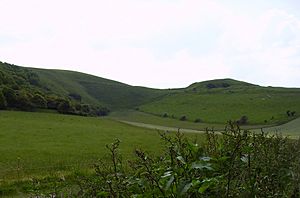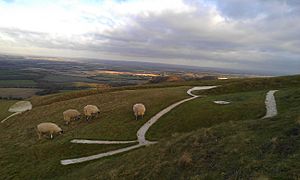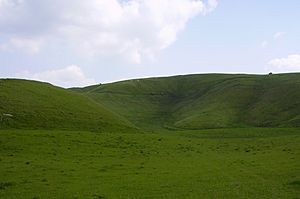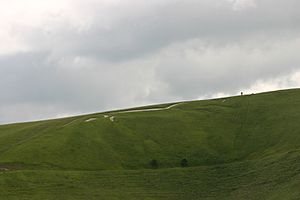Uffington White Horse facts for kids
The Uffington White Horse is a huge, ancient hill figure shaped like a horse. It's 110 meters (360 feet) long and made from deep ditches filled with bright white chalk. This amazing figure is located on White Horse Hill in Uffington, Oxfordshire, England. It's about 8 kilometers (5 miles) south of Faringdon and west of Wantage.
The hill is part of the Berkshire Downs and looks over the beautiful Vale of White Horse. You can see the horse best from an airplane or from across the Vale, especially near villages like Great Coxwell. The National Trust takes care of this special place. It's also a protected ancient monument. In 2003, The Guardian newspaper called it a "masterpiece of minimalist art" that has been protected for over 3,000 years. This famous horse has even inspired other white horse figures to be made.
Quick facts for kids Whitehorse Hill |
|
|---|---|

Aerial view of the White Horse
|
|
| Highest point | |
| Elevation | 261 m (856 ft) |
| Prominence | 79 m (259 ft) |
| Listing | County Top |
| Geography | |
| Location | Oxfordshire, England |
| OS grid | SU301866 |
| Topo map | OS Landranger 174 |
Contents
The Horse's Ancient History
People have known about the Uffington White Horse for a very long time. The first mention of it is in old Welsh writings. A book called the Red Book of Hergest, written between 1375 and 1425, says: "Near to the town of Abinton there is a mountain with a figure of a stallion upon it, and it is white. Nothing grows upon it."
For many years, people wondered how old the horse really was. Some thought it was made by the Celts. Others believed it was created by Alfred the Great to celebrate a battle victory.
When Was the Horse Made?
Scientists used a special test called optically stimulated luminescence in 1990. This test helps figure out how old dirt and silt are. They found that the silt under the horse was from between 1380 BC and 550 BC. This means the Uffington White Horse is Britain's oldest chalk figure!
This discovery shows the horse was made during the Bronze Age. This was around the same time that Uffington Castle was built nearby. It was also a time when horses were becoming very important in warfare in Britain.
Keeping the Horse Clean
For hundreds of years, local people have worked to keep the White Horse clear of grass. This cleaning process is called "scouring." Until the late 1800s, this happened every seven years. It was a big event with a local fair and celebrations.
Francis Wise wrote in 1736 that "The ceremony of scouring the Horse... has been solemnized by a numerous concourse of people." After the cleaning, a festival was held, sponsored by the local lord.
Modern Care and Changes
During World War II, the horse was covered up with grass and branches. This was done so that German pilots couldn't use it as a landmark for bombing raids. After the war, it was uncovered again.
Today, volunteers still re-chalk and restore the horse every year. They use hammers and buckets of chalk to keep it bright white. Without this regular cleaning, the horse would quickly disappear under the grass.
Sometimes, people have made temporary changes to the horse. In 2002, some people added a rider and dogs to the figure. In 2003, an advertisement for the TV show Big Brother was placed nearby. In 2012, a bookmaker added a jockey for a horse racing event. In 2023 and 2024, the National Trust and archaeologists started a project to restore the horse to its original size and shape, as it had been shrinking over the years.
What Does the Horse Mean?

People have wondered if the chalk figure was always meant to be a horse. Some thought it might be a dog or even a sabre-toothed cat. However, it has been called a horse since at least the 11th century. Old records from 1072 to 1084 mention "the White Horse Hill" at Uffington.
Many believe the horse was a tribal symbol for the people who built Uffington Castle. It looks a lot like horses shown on ancient Celtic coinage, which was money used by people in Britain before the Romans arrived. It also looks like horses on the Marlborough Bucket, an Iron Age burial item.
Another idea is that the horse is connected to the sun. Archaeologist Joshua Pollard thinks it might be a "solar horse." This is because of how the horse lines up with the sun, especially in midwinter. Ancient myths often talked about the sun being carried across the sky by a horse or in a chariot.
Features Near the Horse
There are several interesting places close to the White Horse:
- Uffington Castle: This is an Iron Age hillfort located on higher ground above the White Horse. It's a large area enclosed by a well-preserved bank and ditch.
- Dragon Hill: This is a natural chalk hill with a flat top. Legend says that St. George fought a dragon here.
- The Manger: This is a steep, dry valley below the horse. Legend says the White Horse grazes here at night.
- The Giant's Stair: These are terraces on the side of the valley. Some think they were made by medieval farming, or perhaps they are natural formations used for early farming.
- The Blowing Stone: This is a special stone with holes in it, located about two kilometers away. When you blow through it, it makes a musical sound. People think it might have been moved from the White Horse site long ago.
- Wayland's Smithy: This is an ancient Neolithic burial mound, about 1.5 miles southwest of the horse. It's right next to The Ridgeway, an old trackway that passes behind Uffington Castle.
Influence and Symbols
The Uffington White Horse has inspired many other white horse figures. These include the Kilburn White Horse in Yorkshire and the Folkestone White Horse in Kent. There are even replicas of the Uffington horse in places like Mexico and Australia.
The White Horse is also used as a symbol by many groups, especially those in Oxfordshire or Berkshire. For example, it's the emblem of the Vale of White Horse District Council. It also appears in many books, artworks, and songs.
See also
 In Spanish: Caballo Blanco de Uffington para niños
In Spanish: Caballo Blanco de Uffington para niños





